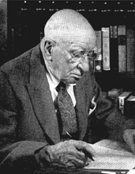Walter F. Willcox: Statist
William R. Leonard
This is excerpted from the article “Walter F. Willcox: Statist,” which first appeared in The American Statistician in February of 1961. The author, William R. Leonard, president of the ASA in 1957, was Willcox’s statistical assistant and one of his last graduate students at Cornell University.“I have long agreed with recent statements that ‘except for statistics … no new technique for studying social problems has been developed in modern times.’”
In the opening words of his preface to Studies in American Demography, published in 1940, Walter Willcox said, “During the last half century, demography, or the statistical study of population, has grown from infancy into lusty youth.” During the same half century, Willcox published what he called “fragments” of an Introduction to American Demography, but found himself handicapped by the then inadequacies of American birth and death statistics. Nevertheless, he pursued his goal and published more than 100 of his “more important writings.” These appeared as monographs and in official government publications, professional journals, encyclopedias, and books.
All these investigations were extremely valuable, illuminating for the first time many diverse problems of American society. In his Studies in American Demography, Willcox wrote, “I have long agreed with recent statements that ‘except for statistics … no new technique for studying social problems has been developed in modern times’ and that ‘it is principally by the aid of such methods that these studies may be raised to the rank of sciences.’ These convictions lie at the root of my predominant interest in statistical sociology.” Willcox’s studies represented pioneering work and improvement of demographic statistics.
Willcox was born on March 22, 1861, in Reading, Massachusetts. He earned his PhD in 1891 from Columbia and an honorary LLD from Amherst in 1906. He joined the faculty of Cornell University in 1891, serving as an instructor and associate professor until 1901, when he became professor of economics and statistics, a chair he held until his retirement in 1931.
Willcox was responsible for initiating one of the earliest university courses in statistics in the United States. Prior to the 1890s, only seven institutions offered courses, described as including statistics. During the 1890s, 16 universities began to offer such courses, among them Cornell in 1892–1893 with “an elementary course in statistical methods with special treatment of vital and moral statistics,” taught by Willcox. It has been said that Willcox and Davis R. Dewey of the Massachusetts Institute of Technology enjoyed the distinction of having taught statistics longer than any other persons in the United States.
From 1899 to 1901, Willcox was one of five professional statisticians in charge of the 1900 Census of the United States and served as chief of the division of methods and results, charged with the analysis and interpretation of the census results. Willcox’s participation in the census of 1900 arose from the work of a committee appointed by the American Economic Association in 1897 to review the 1890 Census and to consider the scope and method of the 1900 Census.
In his capacity as chief statistician for methods and results, Willcox obtained the approval of then Director of the Census William R. Merriam to arrange for analyses and interpretations of the census and the routine reports on populations and vital statistics. To carry out this task, the bureau enlisted the help of the presidents of some 20 universities, inviting them to submit the names of outstanding graduate students who would be willing to assist in the analysis. This approach worked well; a large number of scholars responded and, with Willcox’s participation and supervision, the bureau was able to publish a monumental work in 1906, titled Supplementary Analysis and Derivative Tables, which was a volume of more than 1,100 census-size pages. Thus, many subjects of demographic importance were interpreted for the first time.
Willcox’s interest in vital statistics never flagged. Years later, when civil registration had improved considerably, he was invited by the bureau to prepare a detailed analysis of vital statistics. This appeared as the Introduction to the Vital Statistics of the United States, 1900 to 1930.
Since the census of 1900, Willcox was concerned with the problem of the apportionment of seats in the House of Representatives. He first encountered this problem at the U.S. Census Bureau, whose task it is to prepare the apportionment tables. In June of 1959, he appeared before a subcommittee of the Committee of the Judiciary of the House of Representatives to urge upon Congress an apportionment based on the method of major fractions, a method once used by Congress but subsequently replaced by that of equal proportions. Other methods considered workable include the method of smallest divisors, the method of the harmonic mean, and the method of greatest divisors.


















